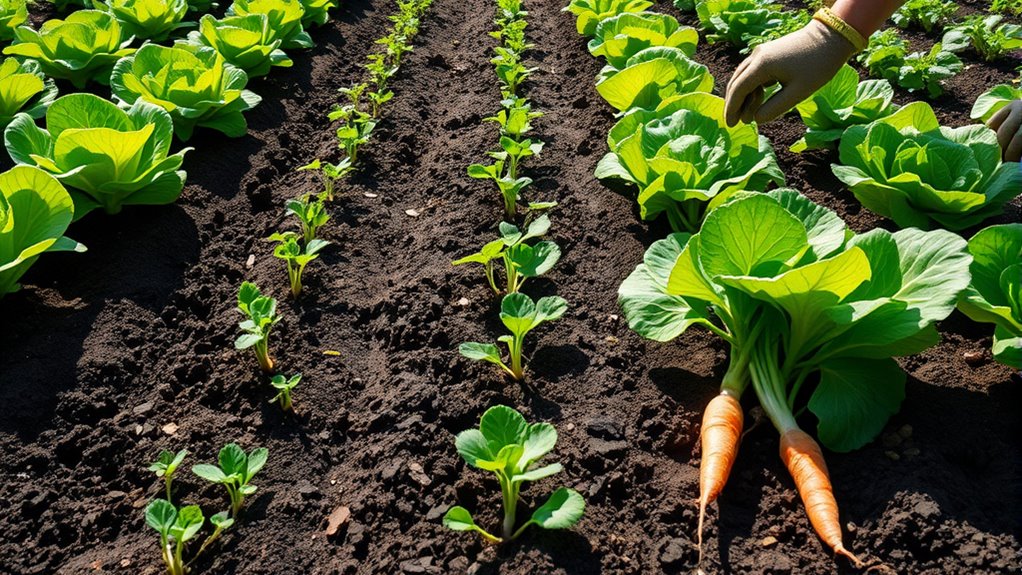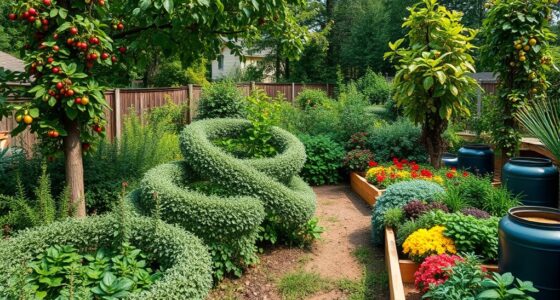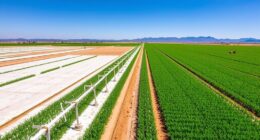To achieve continuous harvests through succession planting, you should stagger your crops by planting at regular intervals throughout the growing season. Start with quick-maturing crops like lettuce or radishes, then follow with beans or peppers as the season progresses. Planning based on your local climate and understanding crop growth cycles is essential. Proper crop rotation and soil care help keep your garden thriving. Keep exploring for more tips to maximize your garden’s productivity.
Key Takeaways
- Plant crops at regular intervals to ensure ongoing harvests throughout the growing season.
- Schedule planting based on crop growth cycles and local climate conditions.
- Rotate crops seasonally to maintain soil fertility and prevent pests and diseases.
- Group plants with similar needs for efficient care and compatibility.
- Track planting and harvest dates to adapt to weather changes and optimize yields.

Succession planting is a smart gardening technique that helps you maximize your harvest by planting new crops at regular intervals. By staggering planting times, you guarantee your garden produces food throughout the growing season, reducing downtime and increasing overall yield. This method requires planning and a good understanding of your crops’ growth cycles, but it pays off when you see your garden consistently thriving.
One of the key elements to successful succession planting is understanding crop rotation. You need to rotate plant families from season to season to prevent soil depletion and reduce the risk of pests and diseases. For example, after harvesting leafy greens, you might plant root vegetables or legumes in that spot the following season. This rotation maintains soil fertility and minimizes the buildup of pests specific to certain crops. When you practice crop rotation, you’re actively managing your soil health, which is essential for continuous planting. Healthy soil means better nutrient availability, stronger plants, and higher yields over time. Without proper crop rotation, you risk depleting critical nutrients or encouraging soil-borne illnesses that can compromise your entire garden.
Crop rotation is essential for maintaining soil health and preventing pests over time.
To implement succession planting effectively, you should plan your planting schedule around your local climate and the typical growing seasons. Start by planting early crops, like lettuce or radishes, and as they mature, prepare for the next round of crops such as beans or peppers. Keep track of your planting dates and harvest times so you can adjust for variations in weather or unexpected delays. This planning allows you to make the most of your space and time, ensuring there’s always something growing in your garden. Additionally, understanding the plant growth cycles helps you better synchronize your planting schedule with natural conditions, optimizing your yields. Incorporating knowledge of crop compatibility can further improve your success by pairing plants that thrive together and support each other.
Furthermore, understanding the soil health and how different crops interact with it can aid in maintaining an optimal growing environment for continuous planting. Recognizing how soil nutrients are depleted and replenished through various crops enables you to amend your soil more effectively, keeping it productive year after year. Another important aspect is understanding the specific needs of each crop, including sunlight, water, and soil requirements. Grouping plants with similar needs simplifies watering and care, helping you maintain a healthy garden environment. When you plant different crops in succession, make sure to amend your soil as needed, adding compost or organic matter to replenish nutrients lost during previous plantings.
Frequently Asked Questions
How Do I Plan a Succession Planting Calendar?
To plan a succession planting calendar, start by noting your growing season and selecting crops with different maturity dates. Incorporate companion planting to optimize space and deter pests, and plan crop rotation to prevent soil depletion and diseases. Stagger planting dates for each crop, ensuring you harvest continuously. Keep a calendar of planting and harvest times, adjusting for weather and soil conditions, so your garden stays productive all season.
What Crops Are Best for Succession Planting?
When it comes to succession planting, you want crops that grow quickly and can be replanted often. Leafy greens like lettuce and spinach, radishes, and herbs are perfect because they mature fast. You should also consider crop rotation to prevent soil depletion and disease, plus companion planting to boost growth and deter pests. These choices keep your garden productive and healthy, turning your thumb green into a thriving, continuous harvest.
How Do I Manage Soil Health Between Plantings?
To manage soil health between plantings, focus on soil regeneration by adding organic matter like compost or cover crops. Practice crop rotation to prevent nutrient depletion and reduce pests. These techniques help maintain soil fertility and structure, ensuring your soil stays productive. Regularly test your soil to monitor nutrient levels and adjust amendments accordingly. This approach keeps your soil healthy and ready for successful successive plantings.
What Are Common Pests in Succession Planting Systems?
You should focus on pest identification to spot issues early and implement pest prevention strategies like crop rotation and resistant varieties. Common pests such as aphids, beetles, and caterpillars can threaten your plants. Regularly inspect your crops, remove affected plants, and use integrated pest management techniques. Staying vigilant helps prevent infestations from spreading and guarantees a healthy, continuous harvest, especially in succession planting systems.
How Can I Extend the Harvest Season Effectively?
Perfectly prolong your produce with proactive planning! To extend the harvest season, prioritize precise crop rotation to prevent pests and disease, ensuring healthy plants thrive longer. Pair this with vigilant pest management to keep pests at bay, avoiding premature plant setbacks. By blending these techniques, you create a continuous crop cycle that keeps your garden productive and picturesque, offering fresh produce longer and maximizing every growing season.
Conclusion
So, after all this talk about perfect timing, it’s amusing how you might find yourself endlessly planting and replanting, only to realize nature rarely cooperates on schedule. Succession planting promises continuous harvests, yet it’s often a dance with unpredictable weather and pests. Ironically, your best-laid plans can be upended by the very patience and flexibility you’ve cultivated. Still, isn’t that part of the charm—embracing the chaos while aiming for that steady, bountiful harvest?










